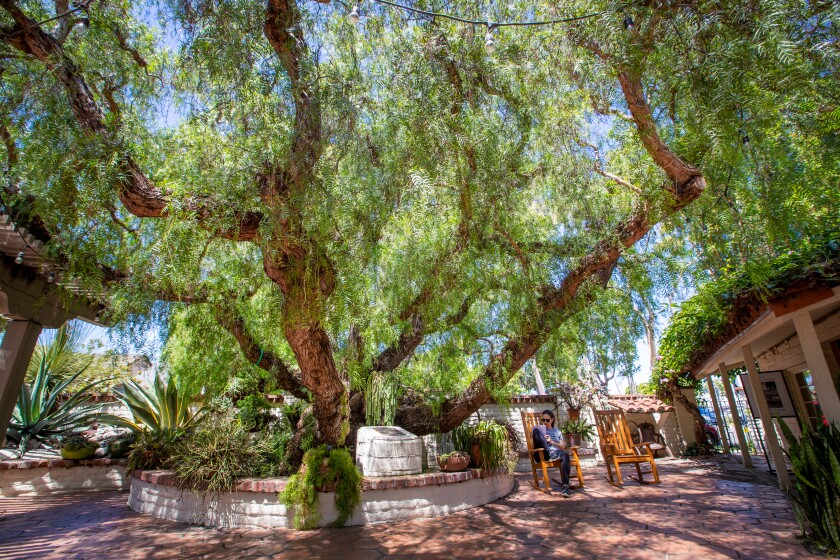
Part 5 — Roadblocks to Repair: A road trip across California
This is the fifth part of a La Jolla Light series that looks at the conditions of area streets, seeking to answer the question, “Why does it seem so hard to get roads repaired?” The series explores the past, present and future of local street repairs and how La Jolla factors into the larger road map of San Diego.
Our series takes a slight detour this week as the Light journeys north to dig into the infrastructure in similar communities throughout California. Are their efforts to repair streets as bumpy as in La Jolla?
Tiburon
This coastal town in Marin County north of San Francisco is “pretty fortunate” when it comes to road repairs, according to Patrick Kerslake, superintendent of Tiburon’s Public Works Department.
“Our [town] council has made a pretty big commitment to funding street repairs because it’s something that’s important to the people here,” he said. The council spends about $1.5 million yearly on the town’s 33 miles of roads, from various sources.
Tiburon is a “very affluent” community of about 9,100 people, Kerslake said, with its own governance and police department. Though property taxes are high on Tiburon’s homes — which had a median listing price of $2.9 million in February, according to Realtor.com — the town sees only about 7 percent of those taxes. The rest is distributed to the school district and Marin County.
Part of that money funds street repairs in Tiburon, which are prioritized according to the town’s Pavement Condition Index, which grades each street every three years, Kerslake said.
Additional funding for street repairs comes from the Bay Area’s Metropolitan Transportation Commission, which allocates gas tax money and other income sources throughout the area.
Kerslake said Tiburon’s policy is to alternate between repaving the worst streets one year and placing slurry seal the next year on roads “that are still decent.” Slurry seal is a pavement preservation method consisting of asphalt emulsion, sand and rock applied to the street surface at an average thickness of a quarter-inch.
It’s often “more economical to rehabilitate” them, Kerslake said.
Just as in San Diego, this can cause frustration among residents, he said, but he believes the system has been effective. “I don’t feel like it’s unmanageable.”
Pacific Palisades

A beach-goer looks out onto the Pacific Ocean from Pacific Palisades in Los Angeles.
(Dania Maxwell / Los Angeles Times)
This affluent coastal community within the city of Los Angeles is home to nearly 29,000 people and a median home listing price of $4 million in February. It’s also historically been a popular residence for Hollywood celebrities.
But that doesn’t mean it gets higher priority for road repairs than other neighborhoods.
“Prioritization by community” doesn’t happen in Los Angeles, according to Elena Stern, senior public information director for the Los Angeles Department of Public Works. “It’s street-based.”
Repairs along the 23,000 miles of streets in Los Angeles are managed under the city’s StreetsLA program “to ensure it aligns with the city’s equitable social, economic and environmental vision and policies,” Stern said.
“The focus is on … resource allocation and utilization to build, preserve and operate street service more cost-effectively,” she said.
She said the StreetsLA framework includes the Pavement Preservation Program and Pavement Management System, which use various factors and incorporate feedback from City Council districts to choose streets for resurfacing based on eligibility for available funding sources.
Newport Beach

A visit to Corona del Mar in Newport Beach can include a tour of Sherman Library & Gardens.
(Allen J. Schaben / Los Angeles Times)
In this upscale coastal city in Orange County with an estimated population of nearly 83,000 — approximately twice that of La Jolla — neighborhood infrastructure is considered a long-term priority and is written into City Council policy, according to Public Works Director Dave Webb.
The area’s streets are in good condition, he said, because “there is science and art to it, dedicated effort, good oversighting council policy, that all guide our planning.”
Newport Beach contains Corona del Mar, a seaside neighborhood known for its beaches, tide pools, cliffside views and village shops — much like La Jolla.
Webb said the city strives to make sure streets are tended to equally, which he acknowledged is a “complex process.”
But “it starts with having and committing to long-term vision and making equitable street repairs a higher priority than something else,” he said. “We want our streets to stay in good condition, so our policy is committed to good infrastructure.”
Webb said dollars are attached to planning efforts ahead of time so there is always funding, regardless of other budgetary restraints and rotating city leadership.
“Streets are long-term investments that deteriorate over the long term, which can be a good thing or a bad thing,” Webb said. “Local governments tend to be slightly shorter-sighted. So keeping an eye on infrastructure that deteriorates slowly is hard. But roads are the foundation of a city. When towns get started, there are roads first, then libraries, fire stations and homes.”
Therefore, keeping them in good condition is a high priority, he said.
Of the city’s general fund, $5 million goes to infrastructure “off the top,” Webb said. “Whenever there is a budget surplus, half [that] money is put to neighborhood enhancements.”
“The better your infrastructure and roads look, the better your property values,” he said. “A lot has to do with philosophies and some has to do with economics. There are choices to be made that involve looking beyond election cycles. For elected officials, it can be hard to make that choice.”
New elected officials in Newport Beach meet with the Public Works Department for an information session on long- and short-term infrastructure and budget options, the life cycle of a street and more.
The city also focuses on preventive maintenance, which Webb said is much cheaper than rebuilding a street and “yields savings over time.”
In San Diego, slurry seal costs $130,000 per mile.
Asphalt overlay — installing a new layer of asphalt on top of the existing surface at a thickness of one to three inches — costs around $880,000 per mile.
Total reconstruction of a street costs about $6 million per mile.
“The city will pay up in the short term for maintenance,” Webb said, “but there is also a long-term plan in place to replace underground infrastructure and then replace the street and look at the ones that are in lower condition.”
Coming in Part 6: The road ahead: What’s next for La Jolla’s streets? ◆
